

How can I determine if a journal is peer reviewed? - SNHU Library Frequently Asked Questions. How to recognize peer-reviewed journals. Citation. Academic Writing and Publishing Matters for the scholar researcher. Critical Thinking. AcademicWritingandCitationScript. Traditional Academic Essays in Three Parts. An introduction is usually the first paragraph of your academic essay.
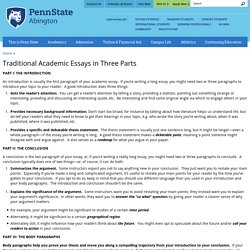
If you’re writing a long essay, you might need two or three paragraphs to introduce your topic to your reader. A good introduction does three things: Gets the reader’s attention. You can get a reader’s attention by telling a story, providing a statistic, pointing out something strange or interesting, providing and discussing an interesting quote, etc.
Irvin what is academic writing. Claims Claims Claims. The importance of writing an effective abstract when you submit a journal article (essay) Conclusions – University of Lynchburg. Poorvu Center for Teaching and Learning. How to Write a Discussion Section. The discussion chapter is where you delve into the meaning, importance and relevance of your results.
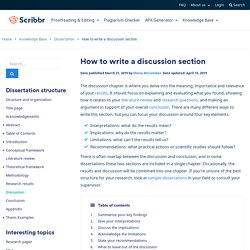
It should focus on explaining and evaluating what you found, showing how it relates to your literature review and research questions, and making an argument in support of your overall conclusion. There are many different ways to write this section, but you can focus your discussion around four key elements: Interpretations: what do the results mean? 17 Cool Resources to Fall in Love With Academic Writing. RESEARCH METHODS: WRITING: LITERATURE REVIEW.
APA Guidelines and More! Citations: Cite Everything! "So What? A Question to be Answered. Nominalization - Expository Prose - Scholarly Writing. How Use Evidence to Support Expository Prose? Writing for Journals. APA Style Blog. A Plea to Faculty: Rethink Student Writing Assignments. Check your grammar and more. HG on Writing. Research Designs in Education. Bentz and Shapiro (1998) in the chapter five (“The Scholarly Practice – Facing the Loss of Identity through the Onslaught of the Information Age”) suggest scholarly practitioners to accomplish their research project with good groundwork.
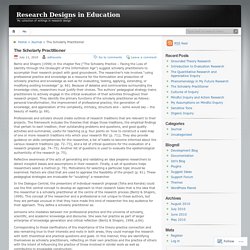
The researcher’s role involves “using professional practice and knowledge as a resource for the formulation and production of scholarly practice and knowledge as well as for evaluating, testing, applying, extending, or modifying existing knowledge” (p. 66). Because of debates and controversies surrounding the knowledge crisis, researchers must justify their choices. The authors’ pedagogical strategy trains practitioners to actively engage in the critical evaluation of their activities throughout their research project. False Positives on Plagiarism. The Research Canvas - John Latham. What is Great? - Video - John Latham.
What is Expository Writing? - Definition & Examples. This lesson will assist you in identifying and understanding the major components of expository writing.

Learn more about expository writing and see some common examples. Then, test your knowledge with a quiz. Explore our library of over 10,000 lessons Click "next lesson" whenever you finish a lesson and quiz. Got It You now have full access to our lessons and courses. Expository Writing vs. Technical Writing. Expository writing and technical writing make up the majority of the text that we see in our everyday lives.
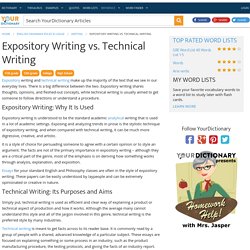
There is a big difference between the two. What Is Expository Writing? What is expository prose? Expository Writing (Exposition) What is exposition?
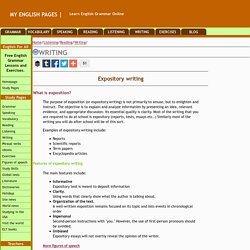
The purpose of exposition (or expository writing) is not primarily to amuse, but to enlighten and instruct. The objective is to explain and analyze information by presenting an idea, relevant evidence, and appropriate discussion. Its essential quality is clarity. Explainresearch expository types. Types of Text: Narrative, Expository, Technical & Persuasive. The Differences in Expository & Technical Writing. How to Write an Explanatory Essay (7 Steps) Welcome To Expository Prose Writing, Page 1. Welcome to The Muse Of Language Arts feature on the subject of expository prose writing.
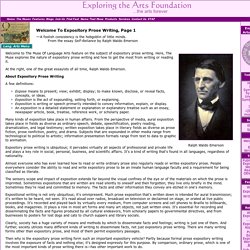
Here, The Muse explores the nature of expository prose writing and how to get the most from writing or reading it. At the right, one of the great essayists of all time, Ralph Waldo Emerson. Characteristics of an Expository Essay. Expository Writing - Definition and Examples. 10 Ways Expository Writing Skills. Handbook. Purdue OWL. Contributors:Jack Baker, Allen Brizee, Elizabeth Angeli.Summary: The Modes of Discourse—Exposition, Description, Narration, Argumentation (EDNA)—are common paper assignments you may encounter in your writing classes.
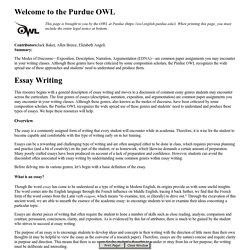
Although these genres have been criticized by some composition scholars, the Purdue OWL recognizes the wide spread use of these approaches and students’ need to understand and produce them. This resource begins with a general description of essay writing and moves to a discussion of common essay genres students may encounter across the curriculum. The four genres of essays (description, narration, exposition, and argumentation) are common paper assignments you may encounter in your writing classes. Although these genres, also known as the modes of discourse, have been criticized by some composition scholars, the Purdue OWL recognizes the wide spread use of these genres and students’ need to understand and produce these types of essays.
Overview. Avoid Qualifiers in Expository Prose. Why “as cited in” should be avoided in academic writing. For my graduate students… and other readers: When you are referencing others’ work in our course, whehter it is on the discussion board, in your presentation or in your final paper, I urge you to find the primary sources for your citations.
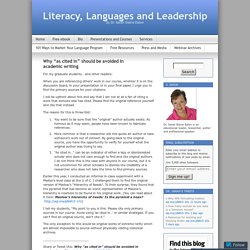
I will be upfront about this and say that I am not at all a fan of citing a work that somone else has cited. Please find the original reference yourself and cite that instead. The reason for this is three-fold: You want to be sure that the “original” author actually exists. Earlier this year, I conducted an informal in-class experiment with a Master’s level class at the U of C. Secondary Sources - Citations - Academic Guides at Walden University. Citations. Secondary Sources (aka How to Cite a Source You Found in Another Source) By Timothy McAdoo You’ve probably heard that you should avoid secondary sources when possible.

It’s true—if you find great information being quoted or paraphrased somewhere, it’s well worth your effort to track down the original source so you can read it for yourself and therefore cite it directly. But why track down the original when you already have the quotes? First, by reading the full text of the original source, you can verify that the context of the quote supports the point you want to make. You don’t want to be surprised by an informed reader who tells you that the original source actually contradicts your points—especially if that informed reader is your professor! Second, by finding and reading the original source, you will become better informed about your research topic. Should I cite the primary sources if I have come across them in a secondary source? When I read through an introduction of an original article by author S(2001), I found it a good source for my literature search. For instance, I came across the following paragraph: “Research has typically addressed modelling and imagery as separate and distinct process.
However, several investigators have noted that modeling and imagery are actually quite similar (Druckman & Swets, 1988; Feltz & Landers, 1983; Housner, 1984; Mccullagh & Weiss, 2001; Ryan & Simons, 1983; Vogt, 1995). Both of these processes include the use of cognitive representations.” I would like to use this idea in my manuscript in this way: “Cognitive process of motor imagery is similar to the that of modeling(reference source will be mentioning here in this bracket)” and then I would like to reveal the reference source to support where the idea is from. However, I thought it’s okay to cite the source from the author S(2001) only but I got to know he actually also cited multiple sources from other sources.
Voice. Rhetorical modes. Exposition[edit] Expository writing is a type of writing where the purpose is to explain, inform, or even describe.[1] It is considered to be one of the four most common rhetorical modes.[2] Argumentation[edit] 200 Prompts for Argumentative Writing.
Clifford's Advice on Writing. 6th ed., copyright 2005, by Dale Lothrop Clifford History Department Policy on Plagiarism and Cheating Simply put, plagiarism is the act of appropriating the work of someone else and passing it as your own. In college work, the obvious case is the term paper bought, borrowed, or stolen from another person and turned in as one's own. However, the most common forms of plagiarism arise from sloppy paraphrases and quotations. A paraphrase must do more than change a few words of the original, and a direct quotation (whether a phrase or a page or two) must appear with a footnote/endnote to credit the original author, and quotation marks.
When you use someone else's research or ideas (including that person's idea of how to put together a particularly good sentence or phrase), you must attribute the material to its author. For a longer discussion of plagiarism, see the American Historical Association's Statement on Standards of Professional Conduct. A period says stop. Essay Writing. Summary: The Modes of Discourse—Exposition, Description, Narration, Argumentation (EDNA)—are common paper assignments you may encounter in your writing classes.
Although these genres have been criticized by some composition scholars, the Purdue OWL recognizes the wide spread use of these approaches and students’ need to understand and produce them. Contributors:Jack Baker, Allen Brizee, Elizabeth AngeliLast Edited: 2013-03-11 10:04:15. Free E-Book : Can YOU Read Me Now? How to Use Readability Formulas to Write for Your Target Audience. What causes low literacy or poor reading with many readers? Statistics show that many adult readers are not literate enough to comprehend most text above a fifth-grade reading-level. This may be true, but it is not the reader’s fault for failing to comprehend certain texts – rather it is the writer’s fault for failing to write for his readers.
To help writers and non-writers write text that their readers can understand, StyleWriter-USA.com has published a free e-book called "Can YOU Read Me Now? ESC Online Writing Center. 8 Words to Seek and Destroy in Your Writing. Creating powerful prose requires killing off the words, phrases, and sentences that gum up your text. While a critical eye and good judgment are key in this process, some terms almost always get in the way. 5 Ways to Get Rid of Your Damn Empty Modifiers. 10 top writing tips and the psychology behind them. Bibliographic Management. Technical English. Language variation. Academic Phrasebank – Describing Trends. Dissertation Writing: The Importance of Alignment. By: Dr. Ron Jones As an instructor, one of the greatest challenges is teaching students the importance of directly addressing the topic, discussion questions, or assignment.
Aligning the response with the topic would appear to be a simple task, yet my experience in the classroom indicates the process is difficult for many students. Personal opinions take precedent over proven facts and well-grounded theories. Rambling and off-topic remarks replace intently focused writing concentrated on the assignment subject matter. In writing a dissertation, doctoral students must grasp the concept of complete alignment to address the chosen topic. The problem statement should clearly delineate one problem. The purpose statement flows from the problem statement. American Psychological Association (APA) Documentation M. Zotero.